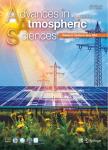Simulated Change in the Interannual Variability of South Asian Summer Monsoon in the 21st Century
Simulated Change in the Interannual Variability of South Asian Summer Monsoon in the 21st Century作者机构:State Key Laboratory of Numerical Modeling for Atmospheric Sciences and Geophysical Fluid Dynamics/Center for Monsoon System Research Institute of Atmospheric Physics Chinese Academy of Sciences
出 版 物:《Advances in Atmospheric Sciences》 (大气科学进展(英文版))
年 卷 期:2010年第27卷第5期
页 面:992-1002页
核心收录:
学科分类:07[理学] 070601[理学-气象学] 0706[理学-大气科学]
基 金:supported bythe National Natural Science Foundation of China (Grant No. 40725016) the National Basic Research Pro-gram of China (Grant No. 2009CB421405)
主 题:climate change interannual variability South Asian summer monsoon ENSO–monsoon rela- tionship
摘 要:This study investigates the projected changes in interannual variability of South Asian summer monsoon and changes of ENSO–monsoon relationships in the 21st century under the Intergovernmental Panel on Climate Change (IPCC) scenarios A1B and A2, respectively, by analyzing the simulated results of twelve Coupled Model Intercomparison Project Phase 3 (CMIP3) coupled models. The dynamical monsoon index (DMI) was adopted to describe the interannual variability of South Asian summer monsoon, and the standard deviation (SD) was used to illustrate the intensity of interannual variability. It was found that most models could project enhanced interannual variability of monsoon in the 21st century. The multi-model ensemble (MME) results showed increases in the interannual variability of DMI: 14.3% and 20.0% under scenarios A1B and A2, respectively. The MME result also showed increases in the rainfall variability are of about 10.2% and 22.0% under scenarios A1B and A2. The intensification of interannual variability tended to occur over the regions that have larger variability currently; that is, "the strong get stronger". Another finding was that ENSO–monsoon relationships are likely to be enhanced in the 21st century. The dynamical component of the monsoon will be more closely correlated to ENSO in the future under global warming, although the ENSO–summer rainfall relationship cannot be reasonably projected by current models. This suggests that the South Asian summer monsoon is more predictable in the future, at least dynamically.



